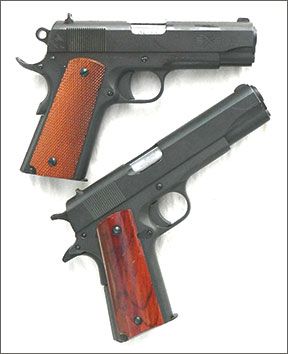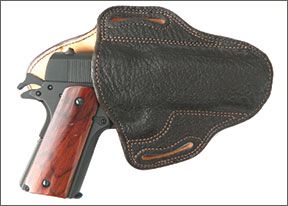We all wish to own a good 1911 pistol, but the top-end 1911 does not fit everyones budget. With the better breed of pistols getting well over one thousand dollars, there is a great deal of interest in 1911 handguns around the six hundred dollar mark. There is even more interest in finding a good used 1911, and that is what we set out to do. After testing inexpensive 45s a few months ago, we went one better and located good used versions of two pistols. We were looking for the proverbial used-but-not-abused type that would give us as much confidence as a new handgun, but at a reasonable discount – say, 40% to 50%. These pistols would not be used in competition or for police service, but rather for recreational shooting and personal defense. For those uses, we did not need a light rail or adjustable sights, but we did expect the piece to perform reliably. With this in mind, we set our sights on a plain-Jane 1911 type with a matte or Parkerized finish and no high-profile sights, aluminum trigger, skeletonized hammer, or front strap checkering. We were able to find two representative examples for just $300 plus tax, one a Commander length ATI 1911 GI HGAFX45 and the other a Rock Island 1911 Standard GI No. 51421, which we had tested as a new gun in the June 2013 issue. Not surprisingly, these were Philippine-produced handguns. Heres how they did:

ATI 1911 HGA FX45 45 ACP,$300 (used), $500 (MSRP)
This pistol was the Commander length, which gave us the ability to compare it to the Government Model-length Rock Island pistol tested. The ATI pistol is manufactured by Sporting Arms Manufacturing or SAM. The pistol appeared well fitted and finished at first examination. The wood grips were nicely checkered, a contrast to the smooth grips found on the Rock Island pistol. Trigger compression was smooth but heavy at 6 pounds. The slide rolled over the locking lugs just fine, the slide lock functioned properly, we found, and the magazine catch operated briskly.
The pistol featured a beavertail-design grip safety. This is a nice feature on an inexpensive pistol. The beavertail is an asset for those who prefer the thumbs-forward grip that sometimes raises the palm from the grip safety. The sights were not GI sights nor Novak types. The rear sight was slightly taller than a GI rear sight, and the front sight was a post rather than a round sight. This was a reasonable improvement over the GI design, and the ATIs sights aided our shooters in quickly acquiring the sights. It was nice getting a good sight picture that doesnt add to the price of the pistol.
The slide lock safety gave us pause. With the pistol cocked, the safety was positive in indent, with the click we like to hear when the safety locks into the slide. However, it was much too easy to take off. There was practically no sound as the safety was moved. It would seem this safety would be easily rubbed off in the holster, and we feel that this looseness is a sign of poor fitting. We attempted to measure the pull weight of the safety with an RCBS trigger pull gauge – something the gauge isnt designed for – and it seemed that the pull weight was just under 2 pounds, while the Rock Island pistol was well over 2 pounds. But the attempt was not exact due to the angles presented.

The pistol was purchased with a single magazine. Our shooters supplemented the factory magazine with a number from the kit, including Metalform 8-round magazines, vintage Wilson Combat magazines, and the new Wilson Combat ETM. We didnt experience any feeding or other function problems with any of the magazines.
Once we ensured the pistol was well lubricated on the long bearing surfaces of the slide, slide rails, and cocking bar, we took to the range. We started testing with a variety of handloads, including a load using the Oregon Trail 230-grain RNL bullet at 780 fps. This was for familiarization. The pistol ran for 100 rounds without a malfunction.
Drawing the pistol cocked and locked from a strong-side holster by Milt Sparks (MiltSparks.com, $102), the shorter ATI pistol exhibited real speed in the hands of a skilled operator. The full-length gun moved between targets more smoothly at longer range, but for the type of chores a defense pistol is designed to handle, the 4.25-inch Commander length felt ideal. Since this is a steel-frame pistol, we really couldnt distinguish recoil amounts between this handgun and the full-length pistol. We ran the ATI gun with three diverse loads in benchrest accuracy testing. Accuracy was adequate to stay on a man-sized target out to 50 yards.
Our Team Said: The pistol never failed to feed, chamber, fire, or eject, and it produced good-enough accuracy. Its sights and beavertail were better than the RIAs, in our opinion, but a heavy trigger and what we saw as poor safety fitting resulted in the pistol being rated down in an otherwise favorable review. The safety fitting could be a non-issue, since some shooters carry the pistol hammer down or leave the chamber unloaded for home ready.
Rock Island 1911Standard GI No. 5142145 ACP, $300 (used),$450 (average new price)
The Rock Island Armory pistol came with a spare magazine and a Fobus paddle holster, so the deal was pretty sweet. The RIA pistol is a 5-inch Government Model. The sights are the embryonic GI types. The pistols finish was smooth enough and even in application. There was one mar in the finish on the slide, showing the pistol had seen some use. The safety and grip safety were GI types, and the trigger was smoother than most other GI pistols weve handled.
Trigger compression was a rather nice 5 pounds, and it felt clean for an inexpensive handgun.
The RIA pistol was a steel-frame pistol with a cast slide and frame. We found nothing to fault the pistol on during the evaluation, but the features were not even with the ATI pistol. In our view, the smooth grip panels were inferior to the ATI in both fit and finish. The sights were smaller and less desirable than the ATI pistol. The ATIs beavertail grip safety and sights definitely received superior marks. The Rock Island pistol did have the superior trigger, however, and also the superior fitting of the slide-lock safety. The RIA pistol is presented as a pure GI pistol, and as such, it represents a good bargain. The ATI is a GI pistol with certain improvements, and we liked the upgrades. The high-profile sights and the beavertail safety are nice to have.
During the initial range testing, the RIA fired and functioned with a range of hollowpoint ammunition. As long as the feed ramp exhibits the proper 1⁄32-inch gap between the frame and the barrel, the 1911 pistol will usually feed properly. Both pistols proved completely reliable with no failures to feed, chamber, fire, or eject. The RIA pistol proved more accurate, but not by a great margin. And remember, the ATI pistol had the shorter barrel by inch compared to the RIA gun.
To illustrate how affordable these two pistols were, we carried the RIA in a holster that was nearly as expensive as the pistol. The sharkskin DM Bullard strong-side holster (DM BullardLeather.com) was brilliantly fast in putting the RIA into action, and as tested runs about $250.
Our Team Said: While we liked the ATI pistol a lot, the RIA is a GI pistol that performed as designed. The RIA pistol was the better shooter, with a good trigger and well-fitted internals. For the money, it would be hard to beat.
Written and photographed by R.K. Campbell, using evaluations from Gun Tests team testers. GT

























